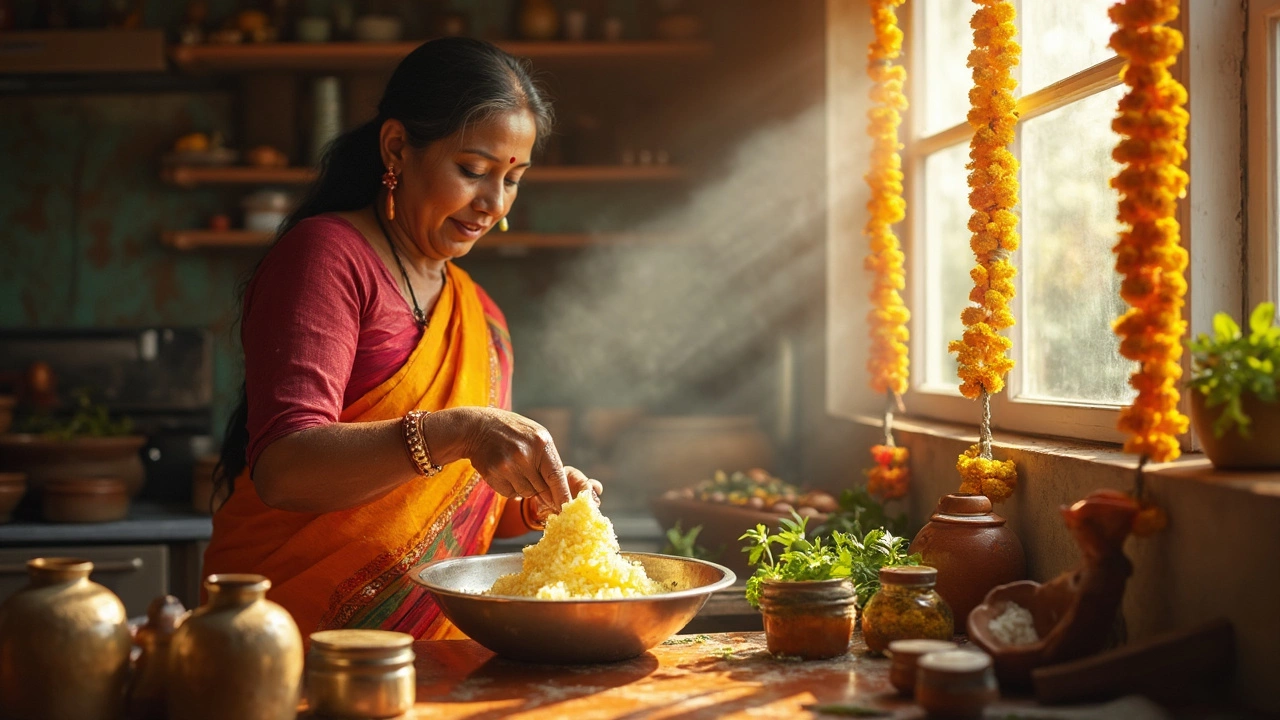When you make paneer at home, you end up with a lot of pale, greenish liquid left in the pot. That’s whey! Most people just toss it out, but should you? Is it actually okay—maybe even a good idea—to drink it?
First off, whey isn’t just watery leftovers. It’s packed with protein, vitamins (like B2 and B12), minerals (like calcium and phosphorus), and little natural sugars called lactose. So, it’s definitely not 'waste.' Some folks even call it 'liquid gold' because there’s so much nutrition hiding in there.
Before you chug a glass, though, it’s smart to ask: Will it suit everyone? Does it taste weird? And what can you really do with all that extra whey from your latest paneer batch?
Most people don’t know there are plenty of easy, clever ways to use that leftover whey in your everyday cooking—or even as a drink for a quick protein fix. But there are also a few situations where you shouldn’t drink it. Here’s what you should know if you’re staring at a jug of whey after making homemade paneer.
- What Exactly Is Paneer Whey?
- Nutritional Value and Health Benefits
- Who Should Avoid Drinking Whey?
- Simple Ways to Use Whey at Home
What Exactly Is Paneer Whey?
Paneer whey is the liquid you get after milk curdles while making paneer at home. The process is simple: you heat milk, add a sour ingredient like lemon juice or vinegar, and once the curds separate from the liquid, what’s left is called whey. Most people drain it off and forget about it, but here’s the thing—this liquid is loaded with nutrients that your body can actually use.
Whey from paneer isn’t the same as the white, creamy milk you started with. It’s usually a clear, yellowish or greenish liquid. That color comes from all the vitamins and minerals dissolved in it. Most importantly, it’s rich in water-soluble proteins your body absorbs easily. When people talk about "whey protein" in fitness shakes, this is the basic stuff they’re referring to—just in a pure, homemade form.
- whey is lighter than milk but loaded with nutrients your body loves.
- It contains good amounts of B vitamins that you won’t find in the solid part of paneer.
- It’s not just water—it carries calcium, magnesium, and even a bit of potassium.
- Whey is low in fat and super low in calories compared to whole milk or paneer itself.
Here’s a quick look at what’s inside 1 cup of homemade paneer whey:
| Nutrient | Amount (per 240 ml/1 cup) |
|---|---|
| Calories | ~20-30 kcal |
| Protein | 1-2 grams |
| Calcium | ~60-80 mg |
| Lactose (milk sugar) | ~2-4 grams |
| Potassium | ~50 mg |
| Vitamin B2 (Riboflavin) | ~0.1 mg |
All these numbers might look small at first, but think about it: when you strain 1 kg of paneer, you get almost 5-6 cups of whey. That adds up to a good amount of extra nutrients for free.
One thing: Whey from paneer is different from the commercial whey you find in powdered form at stores. Commercial stuff is often filtered, processed, and has flavorings added. What you get at home is straight from the source—fresh and without any additives. So, if you’re looking to make the most of your *homemade paneer*, don’t dump that precious liquid.
Nutritional Value and Health Benefits
That cloudy liquid from homemade paneer may not look like much, but it’s loaded with nutrients your body can actually use. Whey is a big deal in the fitness world, but the kind you get at home is just as good for regular folks who want a quick nutrition boost.
The most important thing to know: paneer whey is a natural source of complete protein, especially rich in amino acids. It's got hardly any fat and very few calories, so it’s a good addition if you’re trying to eat healthier or build muscle without chugging heavy shakes.
| Nutrient | Per 100ml of Whey |
|---|---|
| Protein | ~0.8g |
| Calcium | ~40mg |
| Lactose | ~1.3g |
| Potassium | ~50mg |
| Calories | ~10 kcal |
Don't be fooled by the small protein amount. If you collect all the whey from a regular batch (about 1.5 to 2 liters), you’re easily looking at 12–16g of protein in total. That’s like eating two eggs—just from the liquid you usually pour down the drain!
But that’s not all. Paneer whey is a solid source of B vitamins—especially B2 (riboflavin) and B12. These keep your energy levels up and support healthy hair and skin. You also get calcium for strong bones, and some potassium to help manage blood pressure.
"Whey from fresh paneer is not just nutritious but also easy to digest and hydrating, making it a smart choice for everyday diets," says Dr. Shikha Sharma, nutritionist and founder of Nutrihealth.
On top of that, whey has a mild, tangy flavor, and because it’s mostly water, it helps you stay hydrated. Some people with digestion problems say paneer whey soothes their guts, although it’s still got some lactose—so keep that in mind if you're lactose intolerant.
- Great for recovery after workouts or illness
- Low in calories and helps you feel full longer
- Helps boost daily protein intake without extra fat
- Rich in electrolytes for rehydration, especially during hot Indian summers
If you’re trying to get more protein, keep your bones strong, or just want to waste less food, drinking paneer whey is a pretty smart move.

Who Should Avoid Drinking Whey?
Right off the bat, whey from homemade paneer isn't for everyone. Some folks might have a reaction or run into trouble if they drink it, even if it’s loaded with protein and vitamins.
- Lactose intolerance: If milk upsets your stomach, especially if you get gas, bloating, or diarrhea, that’s lactose intolerance. Paneer whey still has a good amount of lactose in it. If you’re sensitive, it’s probably best to skip drinking it.
- Milk allergies: This is different from lactose intolerance. A milk allergy means your immune system reacts to proteins found in milk, like casein and whey itself. It can cause rashes, breathing problems, or much worse. If you’ve got a diagnosed milk allergy, stay clear of any type of whey, even from homemade paneer.
- Kidney issues: If your doctor has ever told you to watch your protein intake—for example, with chronic kidney disease—plain whey isn’t a great idea. Too much protein can make kidney problems worse.
- Known digestive problems: If you have gut issues like IBS or you’re on a super strict FODMAP diet, sometimes even the natural sugars and proteins in whey can be irritating.
"People with milk allergies or severe lactose intolerance should avoid any form of whey, as it can trigger allergic reactions or digestive discomfort," says Dr. Tania Boyer, Consultant Dietitian at Delhi’s Fortis Hospital.
To make things even clearer, here’s a quick chart to help you see who should say 'no thanks' to paneer whey:
| Condition | Risk with Paneer Whey |
|---|---|
| Lactose Intolerance | Digestive upset (bloating, gas, diarrhea) |
| Milk Allergy | Allergic reaction (rashes, swelling, difficulty breathing) |
| Chronic Kidney Disease | Protein overload, can stress kidneys |
| Digestive Disorders (IBS, FODMAP diet) | Potential irritation or flare-up |
If you’re not sure how you’ll react, try just a couple of small sips first and see how your body responds, or check with a doctor or dietitian.
Simple Ways to Use Whey at Home
Don’t toss that whey down the drain after making homemade paneer. This leftover liquid is truly versatile—useful for way more than just drinking straight up.
If you’re wondering what to do with it, check out these easy and practical ideas:
- whey is great for kneading dough. Swapping it in place of water when making chapati, paratha, or even pizza base gives your bread a little protein boost and a softer texture. The extra flavor is a bonus.
- Add it to soups, dals, or curries for a nutrition kick. You won’t notice much taste difference, but you’ll know you added those extra vitamins and minerals.
- Blend it into your morning smoothie for extra protein. No one has to know; it blends right in!
- Water your plants with diluted whey (mix with plain water first). The nutrients can give them a gentle boost, especially for leafy veggies.
- Use it for fermenting idli/dosa batter. The natural bacteria in whey can help your batter ferment faster and become a bit fluffier.
- Add it to pancake or cake batters for softer, more flavorful treats.
If you’re actually looking to drink it, chill it in the fridge first. You can squeeze in some lemon, or mix in a pinch of salt and cumin powder for an Indian-style energy drink. It’s best to sip slowly—too much at once can feel heavy, especially if you’re not used to it.
Here’s a quick look at the kind of nutrition you get per cup (around 240 ml) of homemade paneer whey:
| Nutrient | Amount |
|---|---|
| Calories | 12–15 kcal |
| Protein | 1–2 g |
| Calcium | 40–50 mg |
| Lactose | 1–2 g |
| B Vitamins | Small amounts—all natural |
So next time you make paneer, keep that jug of whey in the fridge. You’ll find yourself using it up before you know it—no waste, just extra nutrition in your everyday cooking.
